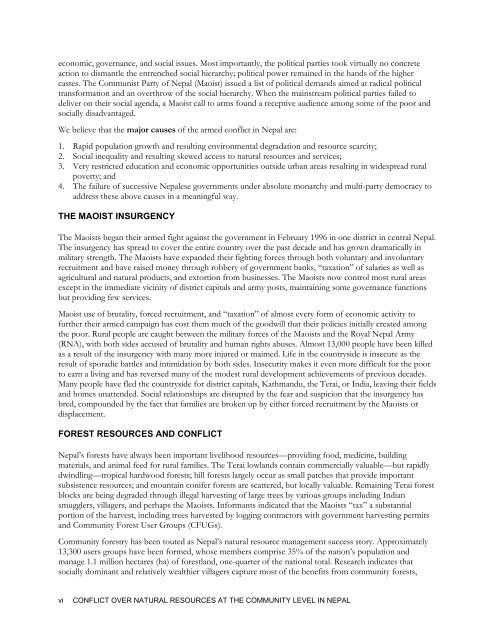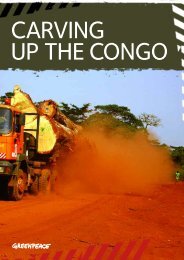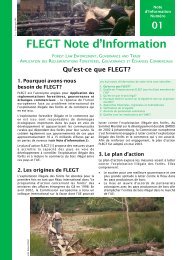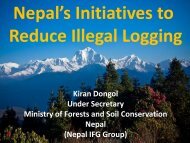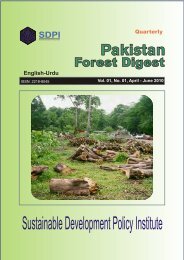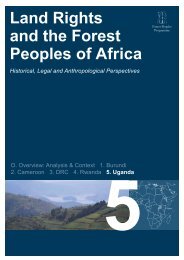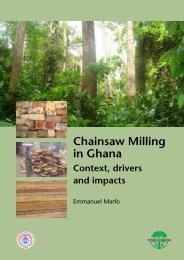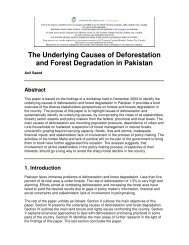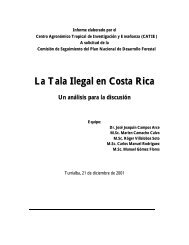conflict over natural resources at the community level in nepal
conflict over natural resources at the community level in nepal
conflict over natural resources at the community level in nepal
Create successful ePaper yourself
Turn your PDF publications into a flip-book with our unique Google optimized e-Paper software.
economic, g<strong>over</strong>nance, and social issues. Most importantly, <strong>the</strong> political parties took virtually no concreteaction to dismantle <strong>the</strong> entrenched social hierarchy; political power rema<strong>in</strong>ed <strong>in</strong> <strong>the</strong> hands of <strong>the</strong> highercastes. The Communist Party of Nepal (Maoist) issued a list of political demands aimed <strong>at</strong> radical politicaltransform<strong>at</strong>ion and an <strong>over</strong>throw of <strong>the</strong> social hierarchy. When <strong>the</strong> ma<strong>in</strong>stream political parties failed todeliver on <strong>the</strong>ir social agenda, a Maoist call to arms found a receptive audience among some of <strong>the</strong> poor andsocially disadvantaged.We believe th<strong>at</strong> <strong>the</strong> major causes of <strong>the</strong> armed <strong>conflict</strong> <strong>in</strong> Nepal are:1. Rapid popul<strong>at</strong>ion growth and result<strong>in</strong>g environmental degrad<strong>at</strong>ion and resource scarcity;2. Social <strong>in</strong>equality and result<strong>in</strong>g skewed access to <strong>n<strong>at</strong>ural</strong> <strong>resources</strong> and services;3. Very restricted educ<strong>at</strong>ion and economic opportunities outside urban areas result<strong>in</strong>g <strong>in</strong> widespread ruralp<strong>over</strong>ty; and4. The failure of successive Nepalese g<strong>over</strong>nments under absolute monarchy and multi-party democracy toaddress <strong>the</strong>se above causes <strong>in</strong> a mean<strong>in</strong>gful way.THE MAOIST INSURGENCYThe Maoists began <strong>the</strong>ir armed fight aga<strong>in</strong>st <strong>the</strong> g<strong>over</strong>nment <strong>in</strong> February 1996 <strong>in</strong> one district <strong>in</strong> central Nepal.The <strong>in</strong>surgency has spread to c<strong>over</strong> <strong>the</strong> entire country <strong>over</strong> <strong>the</strong> past decade and has grown dram<strong>at</strong>ically <strong>in</strong>military strength. The Maoists have expanded <strong>the</strong>ir fight<strong>in</strong>g forces through both voluntary and <strong>in</strong>voluntaryrecruitment and have raised money through robbery of g<strong>over</strong>nment banks, “tax<strong>at</strong>ion” of salaries as well asagricultural and <strong>n<strong>at</strong>ural</strong> products, and extortion from bus<strong>in</strong>esses. The Maoists now control most rural areasexcept <strong>in</strong> <strong>the</strong> immedi<strong>at</strong>e vic<strong>in</strong>ity of district capitals and army posts, ma<strong>in</strong>ta<strong>in</strong><strong>in</strong>g some g<strong>over</strong>nance functionsbut provid<strong>in</strong>g few services.Maoist use of brutality, forced recruitment, and “tax<strong>at</strong>ion” of almost every form of economic activity tofur<strong>the</strong>r <strong>the</strong>ir armed campaign has cost <strong>the</strong>m much of <strong>the</strong> goodwill th<strong>at</strong> <strong>the</strong>ir policies <strong>in</strong>itially cre<strong>at</strong>ed among<strong>the</strong> poor. Rural people are caught between <strong>the</strong> military forces of <strong>the</strong> Maoists and <strong>the</strong> Royal Nepal Army(RNA), with both sides accused of brutality and human rights abuses. Almost 13,000 people have been killedas a result of <strong>the</strong> <strong>in</strong>surgency with many more <strong>in</strong>jured or maimed. Life <strong>in</strong> <strong>the</strong> countryside is <strong>in</strong>secure as <strong>the</strong>result of sporadic b<strong>at</strong>tles and <strong>in</strong>timid<strong>at</strong>ion by both sides. Insecurity makes it even more difficult for <strong>the</strong> poorto earn a liv<strong>in</strong>g and has reversed many of <strong>the</strong> modest rural development achievements of previous decades.Many people have fled <strong>the</strong> countryside for district capitals, K<strong>at</strong>hmandu, <strong>the</strong> Terai, or India, leav<strong>in</strong>g <strong>the</strong>ir fieldsand homes un<strong>at</strong>tended. Social rel<strong>at</strong>ionships are disrupted by <strong>the</strong> fear and suspicion th<strong>at</strong> <strong>the</strong> <strong>in</strong>surgency hasbred, compounded by <strong>the</strong> fact th<strong>at</strong> families are broken up by ei<strong>the</strong>r forced recruitment by <strong>the</strong> Maoists ordisplacement.FOREST RESOURCES AND CONFLICTNepal’s forests have always been important livelihood <strong>resources</strong>—provid<strong>in</strong>g food, medic<strong>in</strong>e, build<strong>in</strong>gm<strong>at</strong>erials, and animal feed for rural families. The Terai lowlands conta<strong>in</strong> commercially valuable—but rapidlydw<strong>in</strong>dl<strong>in</strong>g—tropical hardwood forests; hill forests largely occur as small p<strong>at</strong>ches th<strong>at</strong> provide importantsubsistence <strong>resources</strong>; and mounta<strong>in</strong> conifer forests are sc<strong>at</strong>tered, but locally valuable. Rema<strong>in</strong><strong>in</strong>g Terai forestblocks are be<strong>in</strong>g degraded through illegal harvest<strong>in</strong>g of large trees by various groups <strong>in</strong>clud<strong>in</strong>g Indiansmugglers, villagers, and perhaps <strong>the</strong> Maoists. Informants <strong>in</strong>dic<strong>at</strong>ed th<strong>at</strong> <strong>the</strong> Maoists “tax” a substantialportion of <strong>the</strong> harvest, <strong>in</strong>clud<strong>in</strong>g trees harvested by logg<strong>in</strong>g contractors with g<strong>over</strong>nment harvest<strong>in</strong>g permitsand Community Forest User Groups (CFUGs).Community forestry has been touted as Nepal’s <strong>n<strong>at</strong>ural</strong> resource management success story. Approxim<strong>at</strong>ely13,300 users groups have been formed, whose members comprise 35% of <strong>the</strong> n<strong>at</strong>ion’s popul<strong>at</strong>ion andmanage 1.1 million hectares (ha) of forestland, one-quarter of <strong>the</strong> n<strong>at</strong>ional total. Research <strong>in</strong>dic<strong>at</strong>es th<strong>at</strong>socially dom<strong>in</strong>ant and rel<strong>at</strong>ively wealthier villagers capture most of <strong>the</strong> benefits from <strong>community</strong> forests,viCONFLICT OVER NATURAL RESOURCES AT THE COMMUNITY LEVEL IN NEPAL


